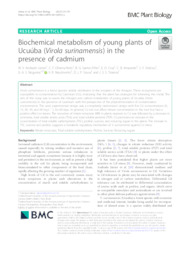Biochemical metabolism of young plants of Ucuúba (Virola surinamensis) in the presence of cadmium.
Biochemical metabolism of young plants of Ucuúba (Virola surinamensis) in the presence of cadmium.
Author(s): ANDRADE JÚNIOR, W. V.; OLIVEIRA NETO, C. F.; SANTOS FILHO, B. G.; CRUZ, E. D.; AMARANTE, C. B.; VINÍCIUS, S. F.; NOGUEIRA, G. A. S.; NASCIMENTO, V. R.; SOUSA, D. J. P.; TEIXEIRA, J. S. S.
Summary: Virola surinamensis is a forest species widely distributed in the estuaries of the Amazon. These ecosystems are susceptible to contamination by Cadmium (Cd), indicating that the plant has strategies for tolerating this metal. The aim of this study was to assess the nitrogen and carbon metabolism of young plants of Ucuúba (Virola surinamensis) in the presence of cadmium with the perspective of the phytoremediation of contaminated environments. The used experimental design was a completely randomized design with five Cd concentrations (0,15, 30, 45, and 60 mg L? 1), for 60 days. In general, Cd did not affect nitrate concentration in the root but had a positive effect on leaves. The reduction of nitrate reductase (NR) in plants exposed to Cd was followed by a decrease in ammonia, total soluble amino acids (TSA), and total soluble proteins (TSP). Cd promoted an increase in the concentration of total soluble carbohydrates (TSC), proline, sucrose, and reducing sugars in the plants. The increase
Publication year: 2021
Types of publication: Journal article
Unit: Embrapa Eastern Amazon
Keywords: Cadmium, Nitrate reductase, Proline, Reducing sugars, Sucrose, Ucuuba, Virola Surinamensis
Observation
Some of Embrapa's publications are published as ePub files. To read them, use or download one of the following free software options to your computer or mobile device. Android: Google Play Books; IOS: iBooks; Windows and Linux: Calibre.
Access other publications
Access the Agricultural Research Database (BDPA) to consult Embrapa's full library collection and records.
Visit Embrapa Bookstore to purchase books and other publications sold by Embrapa.

